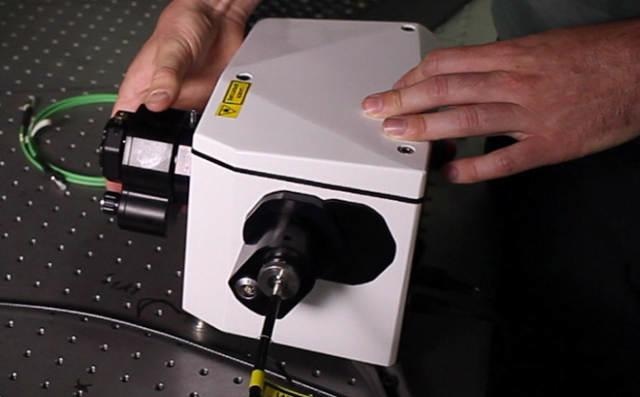A wide range of tunable laser sources (TLS) are available in the market to suit different applications. However, choosing the right technology to suit specific application needs can be a complex process due to the limitations of each technology. This article describes a range of applications where a tunable laser source can be effectively used.

Overview of Tunable Laser Source
The fundamental idea behind Photon etc’s TLS is to utilize a filtering device to choose a single wavelength from a super-continuum source (or white laser). Such pulsed light sources are often used in numerous applications, ranging from lifetime experiment to flow cytometry. However, in the majority of cases, only a small part of the frequency spectrum of the light emitted is required, and hence a tunable filter is often used.
The Laser Line Tunable Filter (LLTF) developed by Photon etc. is a tunable bandpass filter built on volume holographic gratings. These resonant glass gratings are placed in a specific configuration, which allows a section of the super-continuum output to be passed through without affecting its polarization.
The LLTF is capable of a high degree of isolation, up to 70dB, making it ideal for situations that require high sensitivity. It also has a wide tuning range, and excellent pointing stability that enables easy recoupling to mono- and multi-mode fibers.
Applications of Tunable Laser Source
Solar Cell External Quantum Efficiency Mapping
In order to achieve higher solar cell efficiency, it is important to gain a better insight into their basic electronic properties. To that end, Lombez et al.1 explored the spatial differences in the spectral response of CuInGa(S,Se)2 solar cells. In this empirical analysis, Photon etc's versatile TLS was used as the illumination source to measure the light beam induced current (LBIC) at various excitation wavelengths.
The LBIC study estimated the EQE (external quantum efficiency) at different positions of the sample. Also, the LBIC measurements at sufficient positions on the sample enabled a map reconstruction of EQE.
In order to perform this experiment successfully, the illumination source required a high output power and a wide spectral range delivered in a diffraction limited point source to obtain the best spatial resolution.
Keeping all of these requirements in mind, Photon etc’s TLS was selected to stimulate the sample that was placed on a piezoelectric stage to map the EQE for a wide range of wavelengths.
Mechanical Properties of Polypropylene Blends
To better characterize the mechanical properties of solid polymers, a new experimental procedure was developed by Chaudemanche et al.2 that combined Raman spectroscopy with a VideoTraction™ system. The researchers also examined the micromechanisms of deformations in different polypropylene blends and carried out tensile or tension test during which time they noticed the evolution of the integrated Raman intensity.
To obtain information from the Raman data, the researchers performed an incoherent light transport experiment, and ascertained the polymer’s turbidity as a virtue of stress. Following this, the light source was focused on a turbid sample and a CCD camera gathered the halo of the backscattered light emitting from the surface of the specimen.
To carry out the experiment successfully, a low bandwidth, a high pointing stability, and a wide spectral range are required. Finally, the researchers exploited the high wavelength isolation to examine the scattering light at the same wavelength, which was earlier utilized for the Raman experiment.
Advantages of Tunable Laser Source
Photon etc’s TLS (Figure 1) helps in choosing a fast and wide wavelength from the robust and stable Leukos super-continuum sources. Innovative advances in super-continuum white laser technology make it possible to produce the full VIS-NIR wavelength range from a single source. The spectral range moves from UV to NIR with a bandwidth down to 0.4nm. A large tuning range also makes it possible to select highly precise and accurate wavelengths. The TLS serves as a suitable calibration tool for telescopes as well as instrumentation labs.
.jpg)
Conclusion
Photon etc’s tunable laser source is an advanced tool specifically designed to enhance the characterization of mechanical properties of solid polymers. It also enables external quantum efficiency mapping of solar cells and provides a better understanding of the basic electronic properties of these cells. The tunable laser source is a versatile calibration tool for state-of-the-art characterization of different materials.
References
-
L. Lombez, D. Ory, M. Paire, A. Delamarre, G. El. Hajje, J. F. Guillemoles, Micrometric investigation of external quantum efficiency in microcrystalline CuInGa(S,Se)2 solar cells, Thin Solid Films, 2014.
-
S. Chaudemanche, M. Ponçot, S. Adnré, A. Dahoun and P. Bourson, Evolution of the Raman backscattered intensity used to analyse the micromechanisms of deformation of various polypropylene blends in situ during a uniaxial tensile test, J. Raman Spectrosc. 2014.
About Photon etc.
Photon etc. offers state-of- the-art photonic and optical research instrumentation, from laser line tunable filters to widefield and microscopy hyperspectral imaging systems. Its patented spectral imaging and optical sensing technologies provide solutions for a wide variety of scientific and industrial applications. From material analysis to medical imaging, Photon etc.’s expertise and spirit of innovation allow the exploration of uncharted territories.
Photon etc. aims to provide each researcher, engineer and technician with access to the latest innovations in optical and photonic instrumentation. As pioneers in Bragg-based hyperspectral imaging, Photon etc. offers state-of-the-art instruments, driven by its clients’ desires to surpass limitations in measurement and analysis.
Inspired by the scientific creativity found in Montreal and Quebec, Photon etc. promotes open and collaborative innovation and excellence. The dynamic team of this company is proud to offer to its clients innovative and reliable instruments, based on the latest scientific advances in photonics and optics. At Photon etc., the primary wish is to develop a long term relationship with the clients by providing products adapted to their specific needs, combined with personalized service and support.

This information has been sourced, reviewed and adapted from materials provided by Photon etc.
For more information on this source, please visit Photon etc.